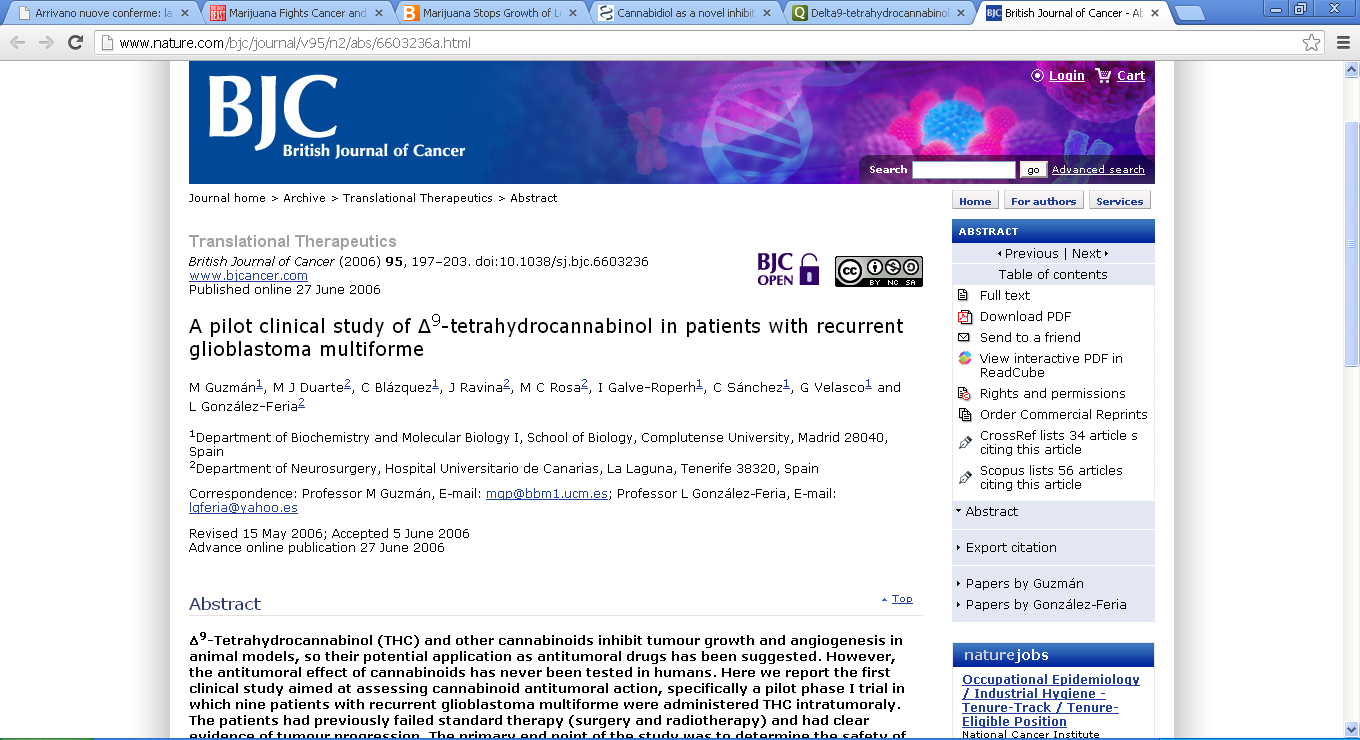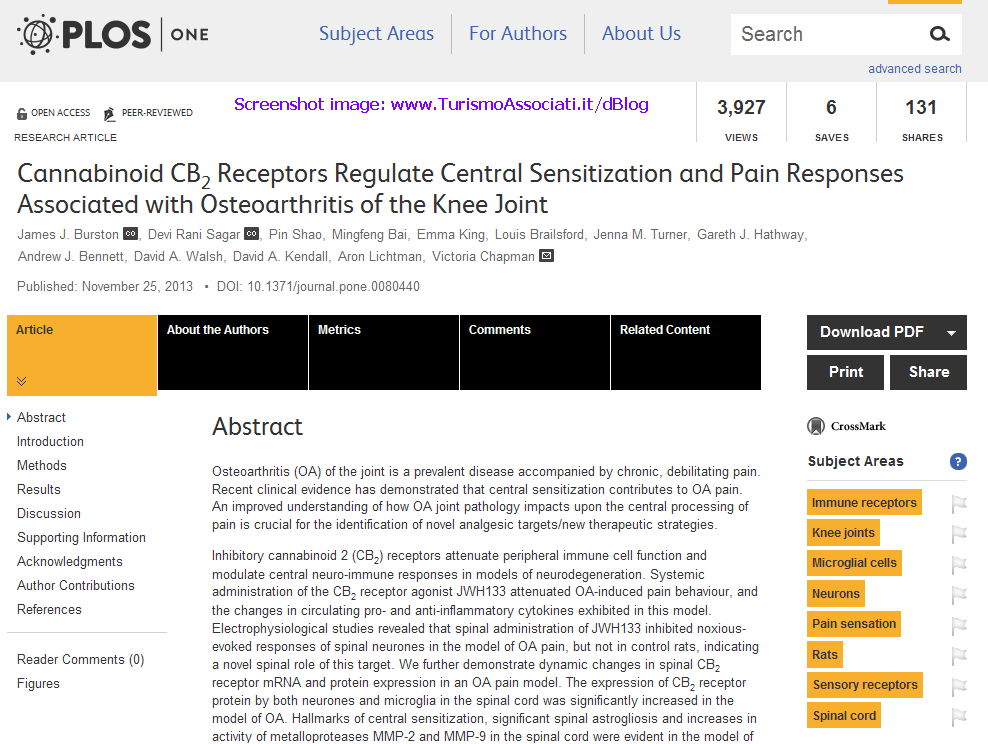|
Di seguito gli interventi pubblicati in questa sezione, in ordine cronologico.
Acute lung injury, also known as acute respiratory distress syndrome (ARDS), is a life-threatening condition caused by acute injuries or infections of the lung.

In the latest study, published in the open-access journal PLOS One, researchers from Brazil and Germany were able to protect mice from acute lung injury by increasing levels of one of the body's own cannabinoids, 2-AG (2-Arachidonoylglycerol).
"It was concluded that MAGL inhibition, and consequently the increase in 2-AG levels, produced anti-inflammatory effects in a murine model of LPS (lipopolysaccharide) - induced ALI (acute lung injury), a finding that was considered a consequence of the activation of the CB1 and CB2 receptors."
Like cannabinoids found in marijuana, 2-AG acts on specific pathways in the body called cannabinoid receptors (CB1 and CB2). Immune cells are known to have a high concentration of these receptors.

By activating cannabinoids receptors, scientists have also been able to control overactivity of the immune system – an underlying factor in a wide range of inflammatory diseases, including acute lung injury.
Since immune cells travel via the blood stream, treatment with cannabinoids could be administered without smoking and still have effect.
The researchers conducted the experiments using a chemical named JZL184, which slows the body's breakdown of 2-AG.
While the results need to be confirmed in humans, the team concludes that targeting cannabinoid pathways of the body could be "a useful therapeutic tool for the treatment of inflammatory lung diseases."
The study received funding from Fundação de Amparo à Pesquisa do Estado de São Paulo (FAPESP) and Cnselho Nacional de Desenvolvimento Científico e Tecnológico (CNPq)
Source: LeafScience
Studies have long shown that marijuana, THC specifically, can temporarily impair learning and memory abilities.
But researchers from Louisiana State University say they've discovered a pathway in the brain that may be responsible for marijuana's effect on memory and learning. According to Chu Chen, PhD, who led the study, disrupting this pathway may be as simple as popping a few over-the-counter painkillers.
"Our studies have solved the longtime mystery of how marijuana causes neuronal and memory impairments. The results suggest that the use of medical marijuana could be broadened if patients concurrently take a nonsteroidal anti-inflammatory drug such as ibuprofen."
Nonsteroidal anti-inflammatory drugs (NSAIDs), which include aspirin and ibuprofen, work by inhibiting the cyclooxygenase-2 (COX-2) enzyme.

In experiments with mice, published in the journal Cell, Dr. Chen and his team managed to link cognitive impairments caused by THC to an increase in COX-2 levels. But giving the mice an NSAID called Celebrex along with THC seemed to prevent these impairments.
More importantly, using models of Alzheimer's disease, the scientists confirmed that Celebrex didn't change the ability of THC to slow disease progression.
"Our results suggest that the unwanted side effects of cannabis could be eliminated or reduced, while retaining its beneficial effects, by administering a COX-2 inhibitor along with delta9-THC for the treatment of intractable medical conditions such as Alzheimer's disease."
The potential of THC to treat Alzheimer's has been the focus of a number of studies, since, as Dr. Chen notes, "there are no effective medications currently available for preventing and treating Alzheimer's disease or halting disease progression."
The study received funding from the National Institutes of Health (NIH)
Source: LeafScience
Besides easing insomnia, marijuana seems to have a wide range of effects on sleep.
This is because chemicals in marijuana, known as cannabinoids, actually mimic the activity of chemicals found naturally in the brain.

These chemicals and their biological pathways make up the body's endocannabinoid system, which is responsible for regulating sleep, among other things.
Likewise, research shows that marijuana can also have a direct impact on sleep. Here's 5 of the most important effects that studies have identified so far.
1. Easier Falling Asleep
Some of the earliest research on marijuana and sleep shows that marijuana's main ingredient, THC, can significantly reduce the time it takes for both insomniacs and healthy people to fall asleep.
In a small study published in 1973, THC reduced the time it took for 9 subjects with insomnia to fall asleep by over an hour on average. However, the researchers noted that too high of a dose could counteract the effect.
THC was also found to ease falling asleep in a 2013 study involving healthy subjects.
2. Longer Sleep
Early studies also revealed that taking either THC or CBD before bed could lead to an increase in overall sleep. In one study, increasing the dose of THC also increased the amount of time spent sleeping.
However, higher doses of THC also caused a "hang over" feeling in some subjects when they woke up, while the feeling was not present at lower doses.
3. More Deep Sleep
Some of the more interesting effects of marijuana on sleep involve its impact on the sleep cycle. Studies show that THC can increase the amount of slow-wave sleep, also known as deep sleep, that an user experiences during their slumber.
This is likely a good thing, since deep sleep is believed to play a major role in the restoration process that occurs during sleep.
What's more, experts believe that the most damaging effects of sleep deprivation result from a lack of slow-wave sleep. For example, research has shown that reduced slow-wave sleep can be a strong predictor of high blood pressure in older men.
4. Shorter REM Sleep
Another way marijuana affects the sleep cycle is a reduction in REM sleep. Many people who smoke before bed report a lack of dreaming, which only occurs during REM sleep.
While less REM sleep could be seen as a negative effect of marijuana use, scientists are still not sure what purpose REM sleep actually serves.
However, people who quit after using marijuana on a frequent basis often experience an increase in REM sleep, also known as the "REM rebound" effect, which is accompanied by an increase in dreaming and restlessness during sleep. But this effect tends to wear off within days or weeks, depending on the individual.
5. Better Breathing
When it comes to medical use, marijuana could offer an incredible benefit to the approximately 25% of men and 9% of women who suffer from a disorder called sleep apnea.
Sleep apnea is characterized by disrupted breathing during sleep, and has been linked to a number of serious conditions, including diabetes and heart problems. Unfortunately, the vast majority of sleep apnea sufferers remain undiagnosed and untreated.
Even of those who seek treatment, many eventually give up on wearing a CPAP mask every night.
But that's where marijuana may help, as researchers are currently trialing THC as an alternative, with early results already showing promise. If clinical trials are successful, sleep apnea patients may one day have the option of swapping a bulky sleep mask for popping a few pills before bed.
Source: LeafScience
HEMP vs. COTTON

Hemp fabric is softer, warmer, more water resistant and more durable.
One acre of usable hemp fiber is equal to two acres of cotton.
Hemp requires no pesticides, but cotton requires high amounts of pesticides.
Growing cotton leaves a scorched earth and polluted waters.
Organic alternatives have a lighter impact, but ultimately organic cotton is not nearly as sustainable as hemp.

Clearing the Smoke, reveals how cannabis acts on the brain and in the body to treat nausea, pain, epilepsy and potentially even cancer.
Investigators from Spain, Italy and Canada now have evidence that cannabidiol (CBD) – a non-psychoactive chemical found in marijuana – exerts a combination of anti-cancer effects at the molecular level.

Published in October 2013 in the open-access journal PLOS One, the results provide "new insights into the antitumor action of CBD, showing that this cannabinoid affects multiple tumoral features and molecular pathways," write the authors, who conducted experiments using CBD and glioma cell cultures.

Led by Paola Massi, PhD from the University of Milan, the team concludes that CBD could offer an effective treatment for brain cancer – without side effects.
"As CBD is a non-psychoactive phytocannabinoid that appears to be devoid of side effects, our results support its exploitation as an effective anti-cancer drug in the management of gliomas."
While marijuana's cancer-fighting potential is not a new discovery, interest has grown in recent years. Earlier, the drug company GW Pharmaceuticals announced the start of the first clinical trials involving cannabis-based medicine as a cancer therapy.
Dr. Massi and her colleagues have also conducted a number of earlier pre-clinical studies on cannabinoids and cancer, with funding from GW Pharmaceuticals.
In their latest report, the researchers summarize what their work has shown so far about CBD's effects, ranging from interfering with the blood supply of tumors (angiogenesis) to triggering tumor cell death (apoptosis).
"We previously demonstrated that the non-psychoactive cannabinoid compound cannabidiol (CBD) effectively limits human glioma cell growth, both in vitro and in vivo, by triggering apoptosis, oxidative stress, inhibition of the lipoxygenase (LOX) pathway and by modulating the endocannabinoid system. In addition, CBD interferes with angiogenesis associated to tumor growth."
While the pre-clinical evidence is strong, it could be many years until clinical trials are completed. In the meantime, the team hopes to conduct further research on the molecular mechanisms influenced by CBD.
The study received funding from the University of Milan and GW Pharmaceuticals
Source: LeafScience
1. Whenever someone is angry and confrontational, stand next to them instead of in front of them. You won’t appear as so much of a threat, and they eventually calm down.
2. Open with “I need your help.” People don’t like the guilt of not helping someone out. When asking for a favor from someone, begin your request by saying “I need your help.” It greatly increases your chances of getting that favor done.
3. Rephrase what the other person says and repeat it back to them. This makes them think you’re listening and really interested in what they’re saying. It makes them feel validated. Obviously, you don’t want to overdo this.

4. If you want someone to agree with you, nod while you talk.This gets the other person to nod too, and they begin to subconsciously think they agree with you.
5. If someone doesn’t like you, ask to borrow a pencil. It is a small enough favor that they won’t say no, and it gets them to like you more.
6. Fold your arms to determine interest. If someone is observing you, they will likely mimic you. Fold your arms, and see if they do it, too.
7. Repeat a person’s name many times during a conversation. It helps you remember it, and makes them like you more.
Source: psychtronics.com
All substance addictions, including marijuana, are defined by guidelines set out in the Diagnostic and Statistical Manual of Mental Disorders (DSM-IV).
Even still, marijuana addiction, also known as cannabis dependence, is both widely debated and widely misunderstood.
Here are 4 myths about marijuana addiction that should've been debunked long ago.

Myth #1 – It's not addictive.
Despite what some may argue, marijuana use can qualify as an addiction under currently accepted medical guidelines.
Under the DSM-IV, marijuana addiction is defined according to general criteria for all types of substance dependence. Admittedly, the definition includes a range of scenarios and may be subjective at times.
But as one example: If you've ever, all at once, happened to experience (I) tolerance, (II) difficulty cutting back, and (III) spent "considerable time" trying to obtain marijuana, then you would've met the criteria for marijuana addiction. Withdrawal symptoms – such as insomnia, cravings and loss of appetite – can also be a sign of addiction.
Overall, a study conducted by NIDA researchers concluded that 9% of people who ever try marijuana will become addicted to it at some point.
Myth #2 – It's highly addictive.
9% might seem like a lot, but it really isn't when you consider the addiction potential of other popular substances: 15% for alcohol, 17% for cocaine, 23% for heroin and 32% for tobacco.
Not to mention, while some may experience difficulty when trying to quit marijuana, the withdrawal symptoms are nowhere near that of heroin or tobacco.
Indeed, it would be more accurate to say that marijuana is significantly less addictive than many recreational substances that are legal today.
Myth #3 – Teen addiction is soaring.
Marijuana addiction among teens is a major focus of debate, and is often cited as a reason to keep marijuana illegal.
There's two problems with this notion, however. For one, many of the most negative claims are also the most scientifically debatable, including statistics like '1 in 6 minors who try marijuana become addicted' and '60% of teenagers in rehab are marijuana addicts'.
Secondly, most agree that teenagers shouldn't be getting marijuana in the first place. Unfortunately, an illegally-run industry tends to make it easier for high school kids to get marijuana – yet harder for responsible adults.
Myth #4 – Addiction is always bad.
So marijuana isn't as addictive as it's made out to be, but is it even that harmful for those who are addicted?
Besides the lack of long-term health problems, frequent marijuana use can sometimes be an effective form of self-medication.
In fact, studies suggest that people with hard-to-identify conditions like ADHD and depression may treat themselves with a daily dose of marijuana, while at the same time mistaking it for a bad drug habit.
For those who realize marijuana's versatility as a medicine, there's perhaps only one thing that makes a daily marijuana habit different from a treatment regimen of prescription pills: One is legal, and the other is not.
Source: LeafScience
Using rat models of osteoarthritis, scientists at the University of Nottingham found that synthetic cannabinoids could relieve pain by interfering with signals at the spinal cord level.
The study, published last month in the open-access journal PLOS One, looked at specific marijuana pathways called CB2 receptors, which the authors note have "well described anti-inflammatory effects" when activated.
They conclude that cannabinoids which activate these pathways may hold promise in treating osteoarthritis, especially during early stages of the disease.
"Our clinical and pre-clinical data support the further investigation of the potential of CB2 receptor agonists for the treatment of pain associated with OA (osteoarthritis), in particular at earlier stages of the disease."

Interestingly, the scientists observed significant changes in the expression of cannabinoid pathways in tissue samples taken from both rats and humans with osteoarthritic joint damage, suggesting that the body naturally facilitates this mechanism of pain relief.
"We report the first evidence for the expression of CB2 mRNA in the human spinal cord, and demonstrate a negative correlation with joint chondropathy (damage). A positive correlation between the extent of chondropathy and pain has previously been reported, supporting the clinical utility of this approach."
Despite the lack of human trials, patients with arthritis have long reported marijuana to be helpful.
According to Jason J. McDougall, PhD, an Associate Professor of Pharmacology and Anaesthesia at Dalhousie University, who was not involved with the study, arthritis patients represent the largest group of Canadians using medical marijuana for any specific condition.
Statistics from Health Canada and the Canadian Consortium for the Investigation of Cannabinoids (CCIC) show that 36% of medical marijuana patients in Canada use the drug to treat some form of arthritis.
Although researchers seem to be taking a special interest in synthetic cannabinoids, Dr. McDougall believes that natural cannabis also needs to be considered "as a way of managing pain effectively."
The study received funding from Arthritis Research U.K. and the National Institutes of Health (NIH)
Source: LeafScience
Published last month in the open-access journal PeerJ, investigators at the University of Reading say the findings strengthen support for chemicals in marijuana as seizure treatments.
"These results provide the first molecular confirmation of behaviourally observed effects of the non-psychoactive, anticonvulsant cannabinoid, CBDV, upon chemically (pentylenetetrazole)-induced seizures and serve to underscore its suitability for clinical development."
CBD (cannabidiol) and CBDV (cannabidivarin) have both shown anti-seizure potential in animal studies, but human trials have so far only involved CBD.

Using rat models, the researchers found that CBDV could suppress not only seizure activity, but the expression of specific epilepsy-related genes as well.
The team focused on a set of genes that are significantly increased in epilepsy and are thought to contribute to the disorder.
"Clear correlations between seizure severity and mRNA expression were observed for these genes in the majority of brain regions of CBDV + PTZ (pentylenetetrazole) treated animals and mRNA expression of these genes was suppressed in the majority of brain regions examined from the CBDV responder subgroup."
While the results can't confirm that gene suppression is directly responsible for CBDV's anti-seizure effect, the authors conclude that it provides "important acute biomarkers for additional investigation" of long-term treatment with CBDV.
The study was conducted as part of an ongoing epilepsy research project between GW Pharmaceuticals and Otsuka Pharmaceutical Co, Ltd.
Source: LeafScience
While many still debate the potential for marijuana to cause schizophrenia, researchers at Harvard Medical School say there has "yet to be conclusive evidence that cannabis use may cause psychosis."

Their latest study, published in the journal Schizophrenia Research, adds support to the role of genetic factors in schizophrenia, and that marijuana use alone does not increase the risk of developing the disorder.
"In summary, we conclude that cannabis does not cause psychosis by itself. In genetically vulnerable individuals, while cannabis may modify the illness onset, severity and outcome, there is no evidence from this study that it can cause the psychosis."

The team, led by Lynn DeLisi, MD, Professor of Psychiatry at Harvard Medical School, compared the family histories of 108 schizophrenia patients and 171 individuals without schizophrenia to determine whether cannabis use was a factor in developing the disorder.
They found that a family history of schizophrenia increased the risk of developing schizophrenia, regardless of whether or not an individual used cannabis.
The authors say further studies should investigate whether marijuana can interact with genetic factors to affect the age at which schizophrenia develops. However, the latest findings provide enough evidence for Dr. DeLisi and her team to conclude that cannabis "is unlikely to be the cause of illness."
Interestingly, the authors also point out that different types of marijuana may play a role in the outcome of schizophrenia.
"The amount of THC is particularly of concern, whereas CBD is the component that is thought to have medicinal value even in schizophrenia."
Indeed, although THC is known to have psychosis-like effects, there is growing evidence that CBD can counter the effects of THC, and may even be useful as a treatment for schizophrenia.
The study received funding from the National Institute on Drug Abuse (NIDA)
Source: LeafScience
|